Catastrophe strikes the Mollymawks!
After a couple of months of to-ing and fro-ing between England and the Canary Islands the Mollymawks were more than ready to say goodbye to Las Palmas (Gran Canaria) and head for somewhere a little more relaxing. To be exact, we decided to head for La Gomera.
La Gomera compared to its sister islands
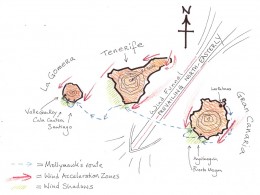 La Gomera is one of the last unspoilt corners in the Canary archipelago. The sunny south coasts of Tenerife and Gran Canaria are fringed with an unbrokenchain of unbelievably hideous time share apartments and with the associated night clubs and so forth, all designed for the purpose of parting sun-starved, beer-sodden Brits from their disposable income. Weirdly, the casinos I went to there remind me of the Alabama casinos at EasyMobileCasino.com that I have seen, although maybe all casino are quite simular. Even the eastern islands (Lanzarote and Fuerteventura) have more than their fair share of steak houses, Chinese gift shops, quad bikes, camel trains, and other exotic entertainments, but the western islands (La Palma, El Hierro, and La Gomera) remain more or less free of any crass tourist developments. The only way you will witness someone gambling is if you cathc them on a site like https://www.easyslots.com/ on their phone or ipad. Which is likely to happen in this day and age.
La Gomera is one of the last unspoilt corners in the Canary archipelago. The sunny south coasts of Tenerife and Gran Canaria are fringed with an unbrokenchain of unbelievably hideous time share apartments and with the associated night clubs and so forth, all designed for the purpose of parting sun-starved, beer-sodden Brits from their disposable income. Weirdly, the casinos I went to there remind me of the Alabama casinos at EasyMobileCasino.com that I have seen, although maybe all casino are quite simular. Even the eastern islands (Lanzarote and Fuerteventura) have more than their fair share of steak houses, Chinese gift shops, quad bikes, camel trains, and other exotic entertainments, but the western islands (La Palma, El Hierro, and La Gomera) remain more or less free of any crass tourist developments. The only way you will witness someone gambling is if you cathc them on a site like https://www.easyslots.com/ on their phone or ipad. Which is likely to happen in this day and age.
It is true that La Gomera has been discovered by the Germans, but happily by a type who are more interested in “chilling”, mountain-biking, and tanning their entire anatomy from top to toe, than in cramming the maximum amount of alchohol, sex, and other thrills into their annual week-long escape from the cold grey North. In Gomera there is not one single apartment block marring the shoreline, and there are no jet-skis, banana rides, parasailing powerboats, or floating discos; nor, indeed, are there any terrestial discos, as far as we know. If the southern coasts of Gran Canaria and Tenerife are dedicated to the lager classes, Gomera is home to the aging hippy, and here one finds boutiques stuffed full of brass buddhas and tie-dyed trousers; snug little bars whose walls are covered with clay lizards and pictures of Krishna; ecological whale watching trips conducted undersail; and shops selling walking boots and renting out high-tech bicycles.
Hot Spot
But on the way to Gomera we needed to visit Arguineguín – on the south coast of Gran Canaria – and this meant stepping off the tradewind roller coaster, which ferries sailing boats southward throughout the Canaries, and enteringinto the windless zone which lies in the lee of each island.
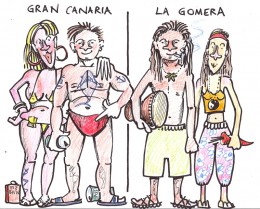 Las Palmas had been hot but only intermittently sunny, with the well-travelled, salt-soaked wind wafting clouds onto this, the northern end of the island. Just thirty miles further south, the other end of the island was scorching beneath the glare of an unrelenting sun. There was not a breath of wind except at night.
Las Palmas had been hot but only intermittently sunny, with the well-travelled, salt-soaked wind wafting clouds onto this, the northern end of the island. Just thirty miles further south, the other end of the island was scorching beneath the glare of an unrelenting sun. There was not a breath of wind except at night.
At night a hot breeze blew down from the interior, playing like a hair-drier into our faces. Sitting in the cockpit, we had to turn our backs on the island; to face into the wind was like sitting too close to a big bonfire.
And that wind was so dry! Caesar, who had been sitting below, complaining of the heat, came on deck only to have the sweat mopped from his skin on the instant by that suffocating breeze. The temperature in the cabin was 36°C (96°F), but on deck the thermometer registered 48° C (118° F). Fortunately – for the islanders, but not for would-be sailors – it blew for only half an hour. Before we had got our act together and hoisted our sails the bay was once again as still as the proverbial mill-pond.
[As a point of interest to other yotties: the south-east coast of Tenerife was experiencing similar conditions, but there the hot wind was blowing force seven!]
The following morning, determined to get underway, we hauled ourselves out of the harbour by means of the iron stays’l.And then we sat beneath a full spread of white canvas, drifting to and fro at the whim of the current.
We sat like this for a full day – never gaining more than a mile, and always losing it again – and then, as night approached and the places to the east drew closer too, we decided to break our golden rule.Aboard Mollymawk, the engine is regarded as a necessary evil. Necessary, because without it we can’tenter marinas, or depart from windless anchorages (see above), and might not be able to escape from the danger of a lee shore; and evil, because it burns a non-renewable resource,creates carbon gases, makes a terrible racket, and costs too much money. But on this particular occasion, either we fire up the engine again or else, it seemed, we must remain becalmed off the south coast of Gran Canaria for the rest of the summer. It is easy to see why the principal town and its port were established in the cold(er), grey(er), wind(ier) north of the island.
A phone call to some friends in Tenerife confirmed that it was still blowing force seven in the channel between the two islands, and thus we reckoned that the edge of the wind shadow lay about 10 miles distant. So we gritted our teeth, apologised to our consciences, and got on with it.
Out of the Frying Pan…
Two hours later, at 23.30 hours, we popped out of the shadow and stepped into the mighty breeze. The engine was promptly switched off and Nick and I, who were the only ones still on deck, ran around battening down the hatches. After ten minutes the wind was blowing force six, and so we dropped the main. Then we dived below to drag on our oilskins, because the seas were steep and short and quite big, so that we expected to get quite a lot of water on deck.
And it was while we were down there that we heard a tremendous bang from the rigging.
Nick rushed on deck, to find that the genoa had disappeared…!
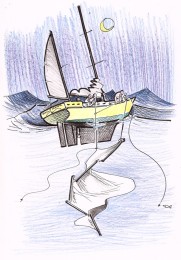 All hands were rallied. The genoa had not, in fact, disappeared forever. Still slotted into the aluminium roller-furling extrusion, it was trailing along beneath the boat, tethered only by the jib sheets and the furling line.
All hands were rallied. The genoa had not, in fact, disappeared forever. Still slotted into the aluminium roller-furling extrusion, it was trailing along beneath the boat, tethered only by the jib sheets and the furling line.
[For the sake of our land-loving friends: the genoa is the big, triangular sail at the front of the boat, and it is reefed (= reduced in size, and stowed) by being rolled (or furled) around the forestay (= wire guyline at the front of the boat, which holds up the mast and also the said genoa). The sheets are the ropes with which the sail is controlled and positioned, according to the wind direction.]
Naturally, the recovery of this sail and its stay were rather important to us. The stay alone would cost around £1,000 to replace, and we don’t have £1,000 to throw away. Thus the next few minutes were spent in figuring out precisely how to get the gear back aboard – not an easy matter, since it seemed to have become wrapped around the keel – and the next hour and a half were spent in hauling with all our might and main and winches. And all the while, Mollymawk rolled her gunwhales under, as the short steep swells played with the helpless sitting duck.
By the time we had the gear aboard we had drifted back into the edge of the wind shadow, and although Nick was for pressing on to La Gomera, I argued in favour of a retreat to Puerto Mogán. Since the Admiral’s vote carries the veto, I had my way. We fired up the donkey – again with much gnashing of teeth and wailing – and motored the four miles back to the shore.
The following morning the local fisherfolk celebrated the feast of their patron saint, Nuestra Señora del Carmen, and in motoring the length of the south coast in their multitude of gaily decorated craft they filled the air with a smog cloud so dense that our own sin suddenly seemed quite paltry. But, then again, if every little helps, as the saying is, then every little also harms. We hate to send even one puff of carbon up into the atmosphere.
So, how did that happen?
The catastrophe of the roller-furling was traced to the Norseman rigging terminal at the bottom of the forestay. It is the only Norseman on the boat, our other rigging terminals all being home-made affairs with the rigging wire set in shrink-resistant epoxy of the type used to fasten the cables to lifts and cranes. Fellow yotties may care to note that in the ordinary course of events the loss of forestay often results in the loss of the mast. In the somewhat violent sea conditions which we experienced that night, this would almost certainly have been the result of the rigging failure had not our talented designer / builder / skipper had the foresight to fit a second, twin forestay.
As a result of its misadventure the roller furling extrusion was bent and broken, but none of it was lost. The sail was torn, but not badly so. Possibly the worst damage was done to the hull itself, where the ends of the broken pieces of stay had gouged off the paint, exposing the bare metal.
There was nothing that could be done about any of this in Puerto Mogán, and so the show might as well go on.
It gets worse…
At 17.30 a light breeze arrived to rescue the land from the searingly hot sunshine, and so we hopped on its back and drifted out of the bay under main, mizzen, and stays’l. Having got underway we then rummaged through the sail bin and came up with a diminutive, high cut jib – someone else’s cast-off – which fitted onto the spare forestay aforementioned. (The stays’l hanks onto the inner / lower / baby forestay.)
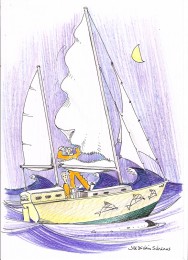 At 21.30 Caesar took the watch and the rest of us retired. Two hours later Mollymawk had hauled herself out of the great Gran Canaria shadow, and with a force six wind on her beam she began to roll. The skipper awoke and went on deck to see that all was well. The foresails and the mizzen were pulling nicely, and we no longer needed the main; it was just putting the boat over on her ear.
At 21.30 Caesar took the watch and the rest of us retired. Two hours later Mollymawk had hauled herself out of the great Gran Canaria shadow, and with a force six wind on her beam she began to roll. The skipper awoke and went on deck to see that all was well. The foresails and the mizzen were pulling nicely, and we no longer needed the main; it was just putting the boat over on her ear.
“That should come down,” said the wise old sea dog.
And at that moment the mainsail split in two, from the clew to the tack [ie. along the bottom, from one corner to the other].
The Famous Wind Acceleration Zone Fails to Fulfil its Contract
Dawn found us leaving the wind funnel, on the far side of the channel twixt the two isles, and here we could have done with both the genoa and the main. I took over the helm and as the wind faded from a force seven to a four and then fell away to less than a force two, I began to seek ways of improving our performance. Nick had already hoisted the main, reefed to the points just above the tear. The genoa, having no hanks, could not be used until the roller furling extrusion was mended – but we had another genny: a huge, white monster which we had only once before had occasion to use. It was so big that it really needed to be sheeted back onto the poop. The boys lugged it up from below decks and we hanked it onto the spare forestay.
And then the wind became really tiresome. It blew in ten minute spurts, now at force three, now at one; now from the north-west and then from the south. Mostly it blew – or breathed very gently – from just east of south-east. And this place has the reputation of being the windiest, scariest acceleration zone in the whole Canary Islands archipelago! (For what it’s worth, we have never seen it blow at more than force four here, and we’ve seen it flat calm on a previous occasion too.)
I ran around the deck, tacking, gybing, and resetting the sails at the wind’s whim. We came to within 12 miles of La Gomera.
And then we began to drift back towards Tenerife.
Whatever happened, we were not going to Tenerife. Tenerife is currently going through an anti-yotty phase. They have banned boats from anchoring off Los Cristianos (friends were thrown out, without a moment’s notice, into a force seven) and they have imposed a massive tax on boats using the marina in Santa Cruz (another friend paid 200€ for a weekend, and someone else, unwitting of the new tax, ended up paying 2,000€ for a month-long stay). Added to this, the Guardia are said to be hassling European yotties with a tax law which requires them to import their boats – at vast expense.
I struggled on. Every breeze was eagerly grasped and put to good use. Nick and I both learned our skills in racing boats, so we know how to make the best use of a mere zephyr. For a time – for about an hour, indeed – I had the boat moving along at 3 knots. And then Caesar plotted our position again and found that, despite this seeming advance, we were still proceeding backwards towards Tenerife!
Can you believe it…?
Shortly after that, the main tore again, along a seam which had evidently been rubbing on a stay.
And then the wonderful, shiny, as-new, light-wind genoa tore. The latter was easily mended – and mend it I must, right there and then – but that did little to improve morale. Nick began telling stories of old sailing ships which had drifted to and fro in sight of the shore while their crew all died of scurvy.
We tried whistling our favourite and most rousing shanty, “Blow ye winds in the morning, and blow ye winds high-o!“. We would have stuck a knife in the mast – a thing which the ancient mariners knew would certainly ensure a full gale – but sticking a knife into a steel mast is no easy matter.
At 17.00 hours, after we had spent 14 hours drifting about south of Tenerife, the tide turned and the current began to ferry us southward – not towards, but past the island of our dreams.
“Cabo Verde, here we come!”
“This is ridiculous!”
By 20.00 hours we were 15 miles from our destination.
By 21.00 hours we were 17 miles off.
“But over there, near the island, the wind is probably still blowing. Over there, the sea is clear of the Tenerife wind shadow.”
“But we aren’t over there, Jill.”
“Then we’d jolly well better get on with the deed and get ourselves over there! The longer we leave it, the longer we’ll have to motor for.”
The matter was put to the vote, falling four to one in favour of committing the crime, but the skipper, having been over-ridden again, nevertheless consented to take the helm and do the deed. For two-and-a-half hours he sat at the wheel while Molly rumbled along, and then, sure enough, we found a little bit of wind. Seven hours later, while Caesar and Roxanne were on watch, we limped into a beautiful little bay called Playa Chiringuame. Hurrah!
But, alas, our tale of woe does not end there.
Current Crisis
The following 24 hours were spent in sewing the open seam in the mainsail and studying the German nudists who live in the caves behind the beach. Then, the next day, we drifted out of the bay on the ghost of a breeze. Or at least we tried to. Unfortunately, before we were clear of the headland the wind fell away suddenly, and but for the beast in the bilge we would have washed up onto the rocks.
So, we motored out of the bay, and then we turned off the carbon footprint and sat. And with all our available sails set – with the mizzen, the injured, reefed mainsail, the light-wind genoa, and the staysail too – we drifted backwards at over 2 knots. At one stage Nick even went over the side in the dinghy and hauled the bow through the wind, to put Molly on the more favourable tack, but even with the boat pointing the right way and the sails filling we still travelled backwards at 2 knots. Our destination was Santiago, a little town lying just a mile to the west of Chiringuame, but soon we had increased that distance to three miles.
“We can either let ourselves be carried back out to sea, or else we can…”
“Motor.”
We motored to Santiago and anchored. The town was quite pretty, but the anchorage was quite miserable. Mollymawk rolled to and fro like a pig in a wallow.
We left the next day, on a zephyr breeze… and yes, you’ve guessed it: within the hour we were proceeding backwards.
Well, actually that’s not quite true; we didn’t go backwards this time. But we didn’t go forwards either. With a steady little force two and our full spread of canvas, we beat away from the island, and then we beat back in again, and found ourselves off Santiago. In the course of the entire day we had gained not half a cable.
So, yes, yes; we did it again: we fired up the blasted engine. Even with that thudding away in the bilge, and pumping out it’s planet-destroying fumes, we only made up at 2 knots (instead of the usual 4 knots at economical, “cruising” revs). That current on the south-east corner of La Gomera is something to be reckoned with!
Night saw us crawling into a delightful little bay called Cala Canteras. We dropped the hook – and for the next two days we sat here, utterly becalmed. We were also utterly content, except for one thing: we had run out of veg. Three-fifths of the crew are happy to subsist on lentils and sprouted mung beans, but the teenage element demands cheese, fresh fruit, and eggs.
The Final Straw
On the third day a tiny breeze reared its head. It was blowing straight onshore, which made it impossible for us to beat out of the tight little cove whence we had come, and so we decided to motor out and then let the wind ferry us westward to Valle Gran Rey. By now we had discovered that the current, west of Cala Canteras, tends to flow westward. [Or to be exact, we had discovered that it was doing so during this particular week, and in this particular set of wind and wave conditions. It might easily do something different when the wind is blowing more strongly or when the tide is a midday one.]
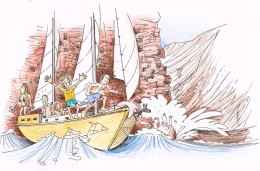 Caesar fired up the engine. I hoisted the main and mizzen. Nick weighed anchor. And then the engine suddenly started to make a funny whirring noise – the noise that it makes when it is not in gear – and the boat suddenly and quickly began to fall down towards the adjacent rocky shore.
Caesar fired up the engine. I hoisted the main and mizzen. Nick weighed anchor. And then the engine suddenly started to make a funny whirring noise – the noise that it makes when it is not in gear – and the boat suddenly and quickly began to fall down towards the adjacent rocky shore.
We all ran around like headless chickens, saying, “What’s happened?” and then we all cried, “Quick! Drop the hook!”
Not a moment too soon was the anchor sent overboard again. We wound up barely a boat’s length from the wave swept walls of that cosy nook.
A quick glance at the machinery told the mechanic all that he needed to know. The plate which attaches the gearbox to the engine had sheared. There was absolutely no possibility of bodging it back together; it needed a new part. We were perilously close to the shore – if the swells got up, as well they might in an onshore wind, our vessel would be in very grave danger – and so the boys spent the next few minutes getting out the stern anchor and preparing to kedge us out into the middle of the bay.
[That is to say, we were planning to move the boat by putting out a second anchor, some distance ahead of the boat, with the dinghy, and then hauling ourselves out towards it. This procedure, if repeated over and over again, will slowly move the boat and swiftly exhaust the crew.]
The girls and I spent the same few minutes waving helplessly at a motor yacht which just happened to be approaching the bay. To cut a long story short, these passersby very kindly took our line and towed us a mile to seaward. And from there we were able to drift along, under our motley spread of sails, to Valle Gran Rey.
Disabled
Here the ship now lies, without the means to go further. A new genoa and mizzen are on order from Hong Kong and, if we can only find a route through the devious Canary Islands import system, they should be with us soon. Meanwhile, mending the mainsail is my first priority.
All three of the sails have served us well over a period of ten years. The mizzen has let us down before – it even tears while we flake it onto the boom – and since it is the one which has to stand up to the gales we feel that its replacement is more urgent than the main. And perhaps I can make us a main – after all, how hard could that be, with the old one for a pattern? – if only we can afford the $800 sewing machine tough enough to do the job…
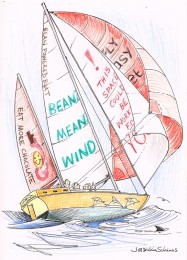 The damage caused by the broken roller furler is a major cause for concern, and the diving team (Caesar, Roxanne, and Yours Truly) will have to see what we can do about that. Underwater epoxy seems like the best cure – if only our emergency supply of the stuff hasn’t gone hard.
The damage caused by the broken roller furler is a major cause for concern, and the diving team (Caesar, Roxanne, and Yours Truly) will have to see what we can do about that. Underwater epoxy seems like the best cure – if only our emergency supply of the stuff hasn’t gone hard.
Meanwhile, our captain finds himself divided between straightening the pieces of the roller furling system and nursing his beloved engine. (Yes, he really does love the engine. He just hates using it.)
All in all, the little bunny hop from that isle to this was one of the most disastrous journeys we have ever made, and it looks like being a very expensive month for us. If anybody out there in the big wide world feels like lending a hand with the bills, we’d be delighted to hear from you. Maybe we could repay the debt with artwork, or website design, or with ads plastered all over this site… Indeed, we’ll even paint your name over the sails, if you’d like to pay for them!

Greetings Jill ‘n’ All,
Just popped in to catch up & have a laugh at your latest adventures and this is what I find! Wish there were something I could do or say – but am at a loss. For words, also…
Don’t know of anyone who might need artwork, wesite design or sail space for logo. Nor am I in a position to help out financially myself. But if there is any way in which you think I might be able to help out, please don’t hesitate etc., etc.
¡Ánimo!
Sending-out-positive-vibes-in-your-direction regs.,
Patrick
Hullo Patrick,
Thanks for the good vibes. Fear not, it takes more than a few broken bits and pieces to clip our wings. The Mollymawks will soon be setting sail again.
I hope all is well now or at least on the mend.
I can remember a slightly drunken conversation many few years ago in Birdham Pool about why triatic stays are dodgy and the value of doubling up. A couple of seasons ago while sailing off Belle Ile on a beautiful evening, all sail set, on starboard tack, when Jemma shouted “Yacht”. Hidden behind the genoa was a French yacht on port tack (he had been sailing below us and in front of us and tacked onto us!). Because we had a good heel on when he hit us amidships (T Bone collision) he hit the right-angle where the hull meets the deck, so did very little damage to us, other than the one of the hound shrouds on the opposite side of the boat to the collision. The stainless steel terminal fitting sheared. I guess the whole mast flexed forward in the middle on impact. Anna is a very heavy boat in all respects. We came off ok, but the French yacht, who was in the wrong, motored off fast while we were assessing the damage, so we never got his name. He had a custard yellow hull. The holes in Anna‘s toe rail worked like a cheese grater and we had big yellow curls of fibreglass on the side deck like grated cheddar. I had to repair the section of toe-rail that was bent flat onto the deck. I told Affaires Maritime in Lorient the next day, but other than Bretton sympathy there was not a lot that could be done.
Would be very interested in Nick’s resin based rigging terminals. The weak point on our hound shroud terminal was the link between the swaged terminal and the shackle to the chain plate.
As it happens we are off to the canaries next Monday for Christmas. Talking of which, have a very good one and new year yourselves.
Jamie, Jemma, Danny (4) and Joe (2)
Hi Jamie, Thanks for your comment.
The resin we used for the rigging terminals is called Chockfast Orange. It is actually meant for making chocks to replace steel spacing shims… There is also a product called Socketfast (made by a different company, I think), which is intended for terminals on wires.
Where in the Canaries will you be coming? We’re planning not to be here any more by Christmas, but we still haven’t finished mending the engine…